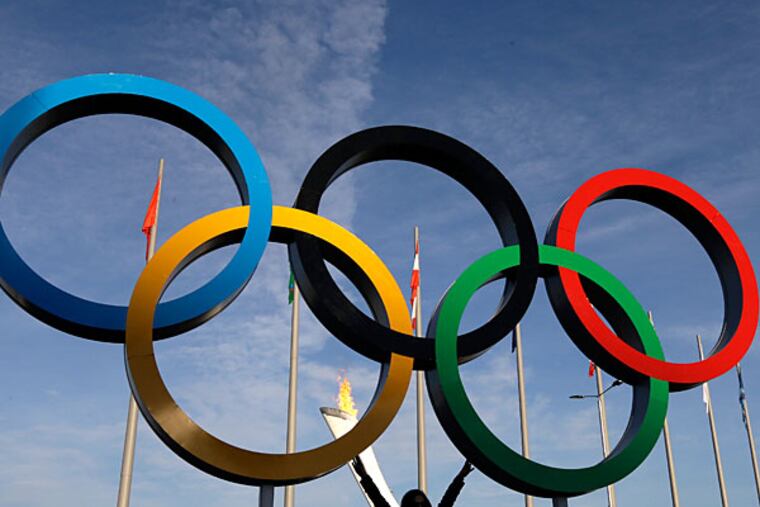Olympic rings generate some controversy
SOCHI - It is a simple and seemingly benign symbol, one meant to signify Olympic ideals such as brotherhood and unity.

SOCHI - It is a simple and seemingly benign symbol, one meant to signify Olympic ideals such as brotherhood and unity.
Created about a century ago by Baron Pierre de Coubertin, the aristocratic founder of the modern Games, the now-familiar Olympic rings have enjoyed a relatively serene existence.
But in one of the oddest developments at these 2014 Winter Olympics, an event so far devoid of any major troubles, the innocuous and ubiquitous symbol suddenly has become controversial.
In one instance, its figurative meaning was distorted. In the other, a physical rendering failed.
Though both were extremely minor issues, they helped reveal just how deeply this grand international spectacle is connected to technology and its commitment to diversity.
Nearly everyone has seen the rings, five interlocking circles of blue, yellow, black, green, and red. They grace the Olympic flag, can be seen in various artistic iterations throughout any Olympic complex, and are featured on merchandise, credentials, signs, and virtually anything else that is Games-related.
According to Olympic historians, the symbol's significance is that its five colors and white background comprise all the colors in the flags of the nations that competed in the Games in 1912.
"The blue and yellow of Sweden," de Coubertin noted at the time in a letter, "the blue and white of Greece, the tri colors of France, England, and America. . . ."
Despite his intentions, however, it has long been assumed that each ring represents a continent and that the continent's identity is revealed by its color - yellow for Asia, black for Africa, etc.
"No, the rings are not assigned to any continent," said Mark Adams, an International Olympic Committee spokesman. "In popular discussion, if you talk to anyone in the street, they tend to think that is the case."
Adams was responding to questions that arose after criticism of a large ring display at Sochi-Adler International Airport. There, even though it was never de Coubertin's intention, each ring is accompanied by the name of a continent.
Some Olympic tourists apparently complained, though it's not known whether they did so because they were offended by the racial stereotyping such a connection implied, or because they saw it as a misrepresentation.
"In either case, I don't think it's a major issue," Adams told reporters.
Neither, it seemed, was the better-known ring controversy that arose just minutes into these Sochi Games. Yet that one created a sizable international reaction.
Early in the opening ceremonies at Fisht Stadium on Friday night, a display of five giant white snowflakes arose from the ground and lifted into the sky.
Four of them electronically morphed into Olympic rings. The fifth did not. While all five then were supposed to burst into white flame, the plan was aborted because of the earlier malfunction.
Somehow a momentary mishap with a snowflake at the start of a $51 billion event that brought together 3,000 athletes from 88 nations became the overwhelming focus of the opening ceremonies.
Sochi organizers were bombarded with questions at a postshow news conference.
"It would be ridiculous for everyone to focus on one snowflake," an exasperated Konstantin Ernst, the show's producer, said at one point. "It would be silly. This certainly is bad, but it does not humiliate us."
Not long afterward, the issue, unlike the electronic rings, ignited again.
The Russian television broadcast, it turned out, had not included the ring malfunction. Instead, when the delayed broadcast aired, film from a successful rehearsal version had been edited into the program, and the audience was not informed.
Ernst insisted that Russian TV was not trying to cover up the glitch but was merely following standard operating procedure.
"It was an open secret," Ernst said of the decision.
More than creating good television, the network said it was just trying to preserve the integrity of a beloved international symbol.
Until now, the only other controversy attached to the Olympic rings came 78 years ago, when they were appropriated by Adolf Hitler for propaganda purposes before Berlin's 1936 Summer Olympics.
Looking for symbols to accompany her film on the Games, German director Leni Riefenstahl had five rings carved into a stone altar in the ancient Greek city of Delphi. Such an iconic image, she believed, would more closely link the Games to their classical origins.
Hitler so liked the resulting imagery that he had the rings plastered all over Berlin.
It was after that notorious chapter, according to Olympic historians, when the symbol came into wide use.